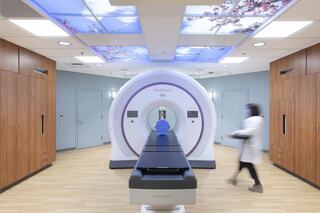Overview of a Linear Accelerator

Hospitals operate a variety of critical, lifesaving pieces of equipment such as CT’s, MRI’s and Linear Accelerators. These complex machines, operating around the clock, are essential for detecting and treating numerous life-threatening illnesses. This imaging and oncology equipment is housed in special, complex rooms that are necessary to support the units while also protecting patients and staff during use.
One such machine is the Linear Accelerator, used to deliver targeted radiation treatments to cancer patients. While some equipment rooms include lighter levels of lead or copper shielding, Linear Accelerators require a particularly extensive amount of shielding that is typically achieved with a combination of concrete, steel and lead, equating to a massive concrete vault that houses the unit.
As equipment ages and technology advances, hospital systems periodically update and replace these Linear Accelerators to improve patient care. Replacing a unit inside the existing concrete vault creates many complexities as every unit has extremely specific requirements for power and data, as well as HVAC system needs. The close coordination of the requirements for structural support, HVAC, electrical and low-voltage systems requires critical coordination amongst the design team, contractor and the equipment vendor.
In the last few years, Lewis has completed numerous major medical equipment installations and replacements across the Pacific Northwest, including four Linear Accelerators in the last 18 months. Watch the video above to get a detailed overview of some of the typical components and challenges in these Linear Accelerator projects.
Hospitals operate a variety of critical, lifesaving pieces of equipment such as CT’s, MRI’s and Linear Accelerators. These complex machines, operating around the clock, are essential for detecting and treating numerous life-threatening illnesses. This imaging and oncology equipment is housed in special, complex rooms that are necessary to support the units while also protecting patients and staff during use.
One such machine is the Linear Accelerator, used to deliver targeted radiation treatments to cancer patients. While some equipment rooms include lighter levels of lead or copper shielding, Linear Accelerators require a particularly extensive amount of shielding that is typically achieved with a combination of concrete, steel and lead, equating to a massive concrete vault that houses the unit.
As equipment ages and technology advances, hospital systems periodically update and replace these Linear Accelerators to improve patient care. Replacing a unit inside the existing concrete vault creates many complexities as every unit has extremely specific requirements for power and data, as well as HVAC system needs. The close coordination of the requirements for structural support, HVAC, electrical and low-voltage systems requires critical coordination amongst the design team, contractor and the equipment vendor.
In the last few years, Lewis has completed numerous major medical equipment installations and replacements across the Pacific Northwest, including four Linear Accelerators in the last 18 months. Watch the video above to get a detailed overview of some of the typical components and challenges in these Linear Accelerator projects.
